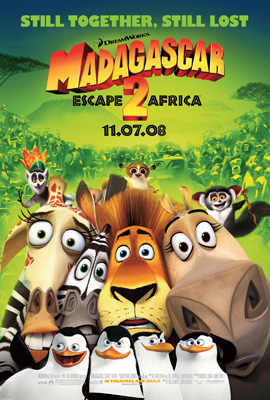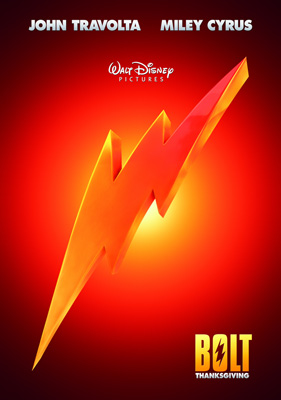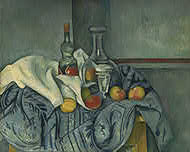
COMMENTARY
Fetch!
What most impressed me when I saw DreamWorks Animation's Madagascar Escape 2 Africa and Disney's Bolt, the two computer-animated features that opened last month, was the sheer virtuosity on display. We've gotten used to the textures that CGI can reproduce perfectly, but in both new films the fur and stone and metal are so insistently real-looking, so inviting to the touch, that it almost seems our eyes have become tactile organs. Human skin is still a holdout, but at least in Bolt skin looks more like molded rubber than like plastic, and that's a genuine step forward. And then there's CGI's simulated camera movement in three dimensions, which directors and animators are using with ever-increasing fluency.
 Unfortunately, both films suffer from disabling flaws. Madagascar 2 is a sequel, and its directors/screenwriters, Eric Darnell and Tom McGrath, simply aren't able to make the case that a sequel was a good idea. I enjoyed the original Madagascar—it's the only DreamWorks feature I've enjoyed —made by the same team, because the filmmakers played down the usual DreamWorks ingredients, like smug and cynical pop-culture references, and emphasized instead the comic incongruities growing out of its zoo-animal stars' thorough assimilation as Manhattanites. Madagascar 2 takes place entirely in Africa, so the incongruities are diminished, and supporting characters from the original film, like a feisty old Jewish lady memorable in a cameo, have been assigned terribly inflated roles in the new one. The lemur king, given amazing voice by Sacha Baron Cohen in Madagascar, is onscreen much longer in Madagascar 2; or maybe it just seems longer, because so little of his new dialogue is as hypnotically deranged as in the original. Even the character design, previously welcome for its stylization, is less impressive in Madagascar 2; when the screen is full of stylized lions, their stylized noses can start to look a little too much like trowels.
Unfortunately, both films suffer from disabling flaws. Madagascar 2 is a sequel, and its directors/screenwriters, Eric Darnell and Tom McGrath, simply aren't able to make the case that a sequel was a good idea. I enjoyed the original Madagascar—it's the only DreamWorks feature I've enjoyed —made by the same team, because the filmmakers played down the usual DreamWorks ingredients, like smug and cynical pop-culture references, and emphasized instead the comic incongruities growing out of its zoo-animal stars' thorough assimilation as Manhattanites. Madagascar 2 takes place entirely in Africa, so the incongruities are diminished, and supporting characters from the original film, like a feisty old Jewish lady memorable in a cameo, have been assigned terribly inflated roles in the new one. The lemur king, given amazing voice by Sacha Baron Cohen in Madagascar, is onscreen much longer in Madagascar 2; or maybe it just seems longer, because so little of his new dialogue is as hypnotically deranged as in the original. Even the character design, previously welcome for its stylization, is less impressive in Madagascar 2; when the screen is full of stylized lions, their stylized noses can start to look a little too much like trowels.
There's a larger problem with Bolt.
The opening sequence, an incredibly intricate and action-packed chase in which the dog Bolt and the girl Penny flee a horde of high-tech bad guys, is a dazzling display of what sophisticated animators can do with CGI, especially when they're abetted by 3-D. But the chase is a set-up: we're told right away, via an irritable TV director, that it's all Hollywood fakery, and that Bolt, who is actually the dog star of a TV series, must not be made aware that his super-powered heroics are not real. His performance would be compromised if he knew that; thus there can be no retakes, and the dog must never see so much as a boom mike.
That's a silly idea for a movie, considering that even the most casual moviegoer is aware of the vast and intricate post-production work (including CGI) that goes into making today's action-adventure spectacles. As any kid could tell you, almost every shot in a movie like Iron Man is composed of hugely expensive layers, with film of the actors only one layer, frequently an insignificant one. But in Bolt's chase, everything not only occurs with uncanny precision, but it is also shot in real time and caught in one take—for a TV show.
A really silly idea, then, but not necessarily a bad idea, for a reason I suggested in Hollywood Cartoons: American Animation in Its Golden Age:
[P]remises as slender as Dumbo's could be more than adequate, as long as they offered opportunities for animation like [Bill] Tytla's. Because the most important animation in Dumbo is so deeply felt, it turns back the questions a critical audience might otherwise be tempted to raise. (Is it even conceivable that an elephant could fly, no matter how large its ears?) ... Here was a wonderful paradox: when a film's animation is emotionally truthful, fantasy of almost any kind is open to it.
John Lasseter, as Disney animation's new Chief Creative Officer, was chiefly responsible for giving Bolt's narrative its distinctive shape, after he booted the director-writer Chris Sanders off the film in 2006. In his remarks about the film, Lasseter has spoken as if he wanted to bring to it some of the "emotional truthfulness" that distinguished the best of Walt Disney's cartoons, and that gave the writers and animators of films like Dumbo such broad latitude for fantasy. He said of Bolt in an interview with comingsoon.net that
< size="2" color="#000000" face="arial">it's just this amazing story of loyalty and friendship that I think had such tremendous opportunity for heart, so I got very excited about it. And then in getting Chris Williams and Byron Howard, the directors on, and really having faith in those directors because they're very funny, but they also have such huge hearts. They knew that this was so important in this film. Walt Disney always said, "For every laugh, there should be a tear." I think this is really a hallmark of that.
But in Walt's cartoons, as in many of the greatest live-action comedies, "heart" is integral to the characters; it enters a film through animation like Bill Tytla's, or acting like Charlie Chaplin's. It's not tacked on, as it is in Bolt and as it has been in such recent Lasseter-produced Pixar features as WALL•E and Cars.
 In Bolt, the efforts to give the story "heart" show up most often in arid stretches of dialogue, as the characters tell us what they're supposed to be feeling. The film hits bottom when Mittens, the Mehitabel-like alley cat who has been dragooned into accompanying Bolt and the hamster Rhino on a cross-country journey back to Los Angeles, reveals in one such exchange not only that she is declawed—and that her toughness is therefore a bluff—but also that her owners abandoned her when they moved away from New York City. I felt not pity for Mittens but irritation that the premise for another movie had been shoehorned into the one I had just paid ten dollars to see.
In Bolt, the efforts to give the story "heart" show up most often in arid stretches of dialogue, as the characters tell us what they're supposed to be feeling. The film hits bottom when Mittens, the Mehitabel-like alley cat who has been dragooned into accompanying Bolt and the hamster Rhino on a cross-country journey back to Los Angeles, reveals in one such exchange not only that she is declawed—and that her toughness is therefore a bluff—but also that her owners abandoned her when they moved away from New York City. I felt not pity for Mittens but irritation that the premise for another movie had been shoehorned into the one I had just paid ten dollars to see.
When I've watched the great Disney features I've never felt the need to know Timothy the mouse's backstory, or Grumpy the dwarf's; everything we need to know about those characters is visible on the screen, in how they are animated. In Bolt, though, there is visible instead the fear that Mittens won't seem real, and that as a result the audience won't care about her; thus the attempt to compensate with the autobiographical stuffing about her mutilated paws.
The filmmakers' fear was justified, I think, and for a by now familiar reason: computer animation has yet to bring characters to life with the immediacy and vitality of the best hand-drawn animation. A growing number of computer animators are doing wonderful things, and I'm sure that many people in the business can distinguish the work of outstanding individual animators. But it is still difficult for character animation by even the most accomplished computer animators to withstand comparison with the great hand-drawn work of the past.
Such comparisons necessarily have a large subjective element, but if you set even the best of today's computer animation beside the best character animation from the past—Tytla's or Frank Thomas's for Disney, perhaps, or Rod Scribner's and Bob McKimson's for Bob Clampett—something will always be lacking in the computer animation, something not encompassed adequately by the usual complaints about, say, the stiffness of the characters' movement. What's missing is the sense that what a character is thinking and doing is occurring at the moment we see it on the screen. Absent what I've called, in my review of The Incredibles and elsewhere, that illusion of spontaneity, no animated character can seem fully alive.
With hand-drawn animation as with CGI, spontaneity can never be more than an illusion, but hand-drawn animation has so far been more successful at creating it. For one thing, hand-drawn's practitioners can come closer to approximating the spontaneity that a live actor can bring to a performance. To paraphrase what Ward Kimball once said about Norm Ferguson, it's possible for an animator with a pencil to draw almost as fast as he can think. With computer animation, though, there's inevitably the sense that what's on the screen has been painstakingly constructed.
Spontaneity can be overrated, however. The internet has recently spawned scans of old funny-animal comic books, many of them drawn by Hollywood and New York animators who did such work on the side. The drawings look truly spontaneous: loose and free and full of a relaxed energy. They have an obvious and understandable appeal to cartoonists who chafe at the fetters contemporary animation imposes. But those old comic-book stories are for the most part shallow stuff, careless when they're not heavily formulaic; the drawings may look fresh and spontaneous, but they're mostly fresh and spontaneous in a predictable way.
 Thinking about such things, I've been put in mind of a couple of great French artists, Renoir and Cézanne, some of whose most famous paintings I saw often when I lived in the Washington, D.C., area. Renoir's brushstrokes dance; he seems like the most spontaneous and open of painters. Cézanne's still lifes, on the other hand, are "constructed" as thoroughly as any CGI cartoon, their brushstrokes assembled painstakingly into sober explorations of the visible world. Renoir is surely the more immediately appealing artist, but over the years it was Cézanne's paintings that I found myself returning to most often.
Thinking about such things, I've been put in mind of a couple of great French artists, Renoir and Cézanne, some of whose most famous paintings I saw often when I lived in the Washington, D.C., area. Renoir's brushstrokes dance; he seems like the most spontaneous and open of painters. Cézanne's still lifes, on the other hand, are "constructed" as thoroughly as any CGI cartoon, their brushstrokes assembled painstakingly into sober explorations of the visible world. Renoir is surely the more immediately appealing artist, but over the years it was Cézanne's paintings that I found myself returning to most often.
Computer animation, it seems to me, has simply been asked to do the wrong things. It is a medium that has been condemned to tasks better suited to hand-drawn animation, and it is waiting for its Cézanne, someone who will turn its sense of construction, of machinery that lurks just beneath perfectly reproduced surfaces, into a tool that artists can use to create beauty of a sort beyond the capabilities of hand-drawn animation. How will that be done, and by whom? I have no idea.
And anyway, it's not going to happen any time soon, at least not in mainstream Hollywood animation. The box office has rewarded not just films like Kung Fu Panda and Madagascar 2, which are basically streamlined and gussied-up versions of hand-drawn cartoons, but also, on a larger scale, the Pixar films, which represent in their totality—Brad Bird's two features emphatically excepted—a clever evasion of the demands that animation makes on real artists. The huge and inexplicable critical acclaim that Pixar's WALL•E has received, culminating in its astonishing selection by the Los Angeles Film Critics Association as best picture of 2008, makes it all the more likely that we are in for lots more animated machines and their equivalents. We're in for lots more synthetic "heart," too, of the kind that bids to become a Lasseter specialty. Cézanne will just have to wait.
[Posted December 13, 2008]